Originally Published 5/1/2011
Ouch!
I am firmly convinced that the evolutionary process made puppies adorable so that we would overlook the fact that their mouths are full of razor blades—blades they do not hesitate to put to frequent use. Nipping and chewing rank high on the puppy parenting complaint list, and are symptoms of teething, a developmental stage associated with both human and canine infants.
Why puppies bite
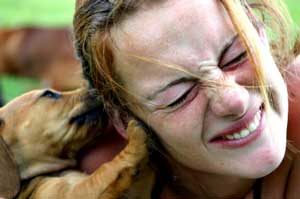
There are a number of reasons puppies nip, bite, and chew. This behavior starts before puppies even leave the litter—as soon as they begin to develop teeth, they begin receiving feedback on their bite strength from their mothers and littermates. With their litters, puppies learn that biting hard leads to loneliness or, worse, hunger! Bite a littermate too hard in play? She’ll likely yelp and stop playing with you until you’ve reclaimed your wits. Bite Mom too hard while eating? You may wind up missing the snack bar as she walks away. Poor, lonely, biting puppies. That is, until they calm down. Then the play party is back on!
Puppies also bite and nip to learn the social mores of dog culture. Dogs don’t play with Legos, video games, and Barbie dolls; they chase, race, tackle, play face-bite games, pounce, tug, and wrestle. This play actually serves a more serious purpose, teaching the lessons that need to be learned so that a dog can survive in canine society. Dogs don’t communicate with verbal language; they communicate physically, through body language and contact. Because dogs don’t have “wars of words,” when the going gets tough, there is often a physical scuffle.
When well-socialized dogs find themselves in conflict, the interaction often looks very scary—teeth flashing, growling. More often than not, these interactions are brief, however, and both dogs walk away without injury. It’s a lot of bluster, but it is a highly ritualized display. If one or more of the dogs is under-socialized, though, the interaction pattern changes and a player is likely to get hurt.
While bite-inhibition training begins while a pup is with its litter, training must continue throughout the dog’s life, with special emphasis during puppyhood. My dog, Mokie, will be six this July, and we still practice bite-inhibition exercises occasionally.
This play actually serves a more serious purpose, teaching the lessons that need to be learned so that a dog can survive in canine society.
Here comes trouble (one more reason!)
Puppies bite because they are teething and learning to control their bite strength, and because nipping is a way to explore and join the social life of dogs. Another reason puppies bite is because it makes exciting things happen; biting earns attention.
Biting for the reaction usually happens after the puppy enters its “forever home.” The typical scene is where the family is quiet, relaxing after a long day. Mom is checking her Facebook account, dad has his feet up watching the game, Suzy is studying, while Johnny plays Xbox. Everyone is ignoring the puppy. Ho-hum.
The bored puppy muses, “How can I get this party started?” Biting often works to get attention, so the puppy zooms around the room leaving a wake of torn pant legs in its path. Ignored no longer, now the entire family is looking at and touching the puppy, and “barking” with excitement (yelling at the puppy). Every family member has put aside what was previously interesting in order to focus on the puppy. Mission accomplished—the party has started! Puppies are very good at training humans to pay attention to them.
Mouth manners for the long-term
Puppy training should emphasize behavior problem prevention in the adult dog. While most puppy classes teach basic manners and commands like “sit,” “down,” and “settle on a mat,” it is far more important to offer exercises and lessons that prevent behavior problems from occurring in the adult dog. Most of my puppy classes have a heavy emphasis on socialization, prevention of resource guarding, and development of bite inhibition.
Puppy training should emphasize behavior problem prevention in the adult dog.
Dogs that are confident and comfortable in their surroundings are less likely to bite. Appropriate and extensive socialization helps dogs learn to be confident and comfortable in many different environments. Teaching bite inhibition, controlling the pressure exerted behind a bite, helps stop a dog from causing significant damage in a situation where the dog feels the need to defend itself with teeth. There is a difference between gentle mouthing (a “nip”) and a bite that sends someone to the hospital. Bite-inhibition training helps puppies learn polite, gentle mouthing—and that human skin is very delicate!
Before discussing techniques and strategies for addressing puppy nipping, I should clarify that nipping and chewing are symptoms of a developmental stage that may last 6 to 9 (or more) months from birth. This is not an issue that will be fixed in a single training session. Consistency is required throughout this puppy period, and regular attention to your dog’s bite strength is a good idea even well into adulthood.
“Do” the right thing
There are things you can do to ensure that your dog develops appropriate “mouth manners.”
DO wait until your puppy is at least 8 weeks old before separating him from his littermates. Puppies learn a lot of lessons about appropriate social interaction, including bite strength, from their dam and littermates. Taking puppies away from their litters too early can prevent them from learning these valuable lessons. Be wary of adopting “singletons,” dogs born without littermates. These puppies miss out on a lot during critical stages of development, including essential feedback about the force they are putting behind their bite!
DO consider letting your puppy stay even longer with the breeder/litter if the breeder is doing a great job with socialization.
DO reserve your spot in a well-taught puppy class before you even bring home your puppy! While many veterinary professionals once recommended starting classes with your dog when the puppy reached 6 months of age (and completed a full round of initial puppy vaccinations), behavior-savvy veterinarians are now changing their positions. Many are now recommending that puppies start in a group class at an early age, as young as 8-weeks-old! Refer to the American Veterinary Society of Animal Behavior (AVSAB) Position Statement on Puppy Socialization for more details. While most puppy-biting is simply nipping, there are cases of aggression developing early in puppyhood; an experienced instructor will realize the difference and help you address the issue promptly.
Reserve your spot in a well-taught puppy class before you even bring home your puppy!
DO make sure that you have plenty of chew toys on hand—pressed rawhide, bully sticks, Nylabones, frozen stuffed Kong products, or even old washcloths soaked in low-sodium chicken broth and frozen are all great treats. Supervise your puppy when he is enjoying his toys.
DO hand-feed your dog. Hand-feeding is a great way to improve your bond with your dog, and it offers you lots of opportunities to practice rewarding him for using his mouth politely! Hand-feeding also teaches the dog that you are a very exciting and rewarding person to spend time with—a bonus! Other family members should practice hand-feeding; encourage guests to hand-feed the dog as well. Of course, small children should not feed nippy puppies by hand. If there are elderly individuals in the home, they should practice this exercise last or wear light gardening gloves when practicing the initial stages of training. Since skin tends to thin as people age, there is a greater likelihood of puncturing.
DO manage and redirect. Crates and tethers are valuable management tools. You do not want to associate crate time with punishment, so when your puppy needs to go in the crate to relax for a bit, offer one of the chew toys you have prepared. Doing so allows you to redirect your puppy’s teething instincts to an appropriate outlet. If you are using a tether, make sure that your puppy is securely attached in an area that has been puppy-proofed. Neither the crate nor the tether area should make the dog feel socially isolated (keep both in a living area and not in a damp, musty corner of the basement).
DO set up play dates with appropriate puppies and tolerant, well-socialized adult dogs. Your puppy-class trainer will instruct you about how to select appropriate playmates, read canine body language and stress signals, and how and when to intervene if play gets out of hand.
DO make sure your puppy is receiving adequate physical and mental stimulation. Sometimes, puppies bite because they are bored and it’s something to do. If it makes people scream, run, and otherwise “freak out” as well, it’s a real party starter for a brassy young pup just looking for a good time. Physical exercise and mental stimulation alone will not eliminate the nipping (maturity and training, however, will), but both can often reduce the frequency and intensity of mouthing behavior.
Make sure your puppy is receiving adequate physical and mental stimulation. Sometimes, puppies bite because they are bored and it’s something to do.
DO learn to “Be a Tree.” You hardly ever see dogs chasing, nipping, or biting at trees. Why? Because they’re boring—they don’t move, squeal, run away, scream, give eye contact, or push the dog away. Trees are just there. “Be a Tree” is a technique that all family members should learn, but it is especially wonderful to teach small children. Contact Doggone Safe to learn more about the “Be a Tree” program and to access some wonderful dog-bite prevention resources.
DO give a dog binary feedback on bite strength. Acceptable use of teeth is rewarded with treats, attention, affection, or whatever the dog likes. Unacceptable use of teeth results in redirection (chew on this in your crate for a while) or negative punishment/removal of opportunity (biting makes people walk away from you). For puppies that continue to chase and bite at you when you move away from them, the tether can be especially helpful. Simply walk out of the tether area, cross the room, sing a verse of your favorite song in your head while ignoring your puppy, and then return to begin a new training session. It is essential that this removal of opportunity is unemotional and that it happens instantly and consistently as a response to using unacceptable bite force.
DO teach your puppy to use his mouth politely. There are many of great resources on the internet and several different techniques you can use. As with all puppy training, work in short sessions (average 10 treats per session). Here are some of my favorite training exercises:
- Teach hand-targeting and/or put “kisses” on cue. These are great new behaviors for your dog to learn, but also teach an appropriate way to interact with hands that can earn reinforcement opportunities!
- Play “I’m ok with that.” This idea comes from one of Karen Pryor’s articles about dealing with puppy nipping. It’s my favorite way to train bite inhibition.
If your puppy bites your hand hard during any of the exercises, stand up, turn your back on the dog, and walk away or “Be a Tree.” Consider practicing when your dog is tethered so he cannot chase and nip you.
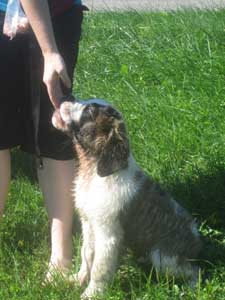
Soft-mouth shaping
Ian Dunbar has a categorization system for ranking the severity of dog bites. The scale may look a little different for a young puppy without severe aggression but with a normal nipping problem. Here’s a sample 5-category scale for that situation, with 1 being the least amount of pressure exerted, 5 the maximum pressure.
- The puppy sniffs or licks the hand.
- The puppy gently mouths the skin. You can feel teeth without pressure.
- Moderate mouthing. Slight pressure is applied to skin, but not enough to cause any puncture or tear.
- The puppy bites hard enough to cause pain, but does not break the skin
- The puppy bites hard enough to break the skin.
There could be additional levels of biting beyond five (the puppy tears the skin, the puppy repeatedly bites the skin, puncturing it, the puppy bites and shakes the hand, etc.). If your puppy is biting at level 5 or higher frequently, consulting with a qualified behavior professional immediately is not optional, but necessary!
Soft-mouth shaping is another technique for teaching a puppy to use its mouth politely. To start shaping a soft mouth, place a low-value treat in your hand and present it to your dog. Any reaction at level 3 or lower earns the puppy a click and the opening of the hand; the dog is fed from a flat palm. A level 4 reaction results in a 5-second removal of the hand (place it behind your back and ignore the dog). Level 5 reactions result in a temporarily lonely puppy—walk away from the dog for 7 to 10 seconds before reengaging him in training. As the puppy develops better control over his mouth, increase criteria so that only level 2 or level 1 responses earn reinforcement.
Mouthing manners: helpful hints
- Introduce movement. It is one thing for a puppy to ignore a stationary hand, but it is much harder to avoid chasing and biting at moving objects. Introduce movement of hands and other body parts slowly while practicing these exercises. If at any point your dog becomes overly aroused by the current level of motion (a six-inch wave of the hand in either direction, for instance), reduce the level of movement (a wiggle of the fingers or a three-inch wave of the hand, perhaps). Reduce movement until your dog is more settled and composed, and then raise your criteria slightly again.
- Some dogs are more inclined to bite ankles than hands. If this is true for your puppy, teach your dog to play with a tug at your side. Redirecting the dog’s natural tendency to chase and bite at things keeps your pant legs safe and builds great toy drive, a valuable conditioned reinforcer for many dogs!
- You can also try tethering your dog and practicing impulse control exercises. Secure your puppy to a strong and stable tether. After asking him to sit, begin clicking and treating for maintaining the position while you shift your weight from your left to right leg and back. If the dog is able to remain sitting while you do this, slowly begin to introduce larger movements, lifting your right leg and shaking it a bit, for instance. Gradually increase your criteria so that you are able to run past your dog, jump up and down, or wave the hem of a flowing skirt in his face while he sits politely, waiting for reinforcement. If at any point in the game your dog becomes overly aroused and nippy, reduce your criteria to the last point at which he was successful and consider splitting your criteria into smaller steps before proceeding.
- Practice initially with low-value treats. Once you complete the training steps with low-value treats, slowly begin introducing treats or toys of higher value. When you introduce a new or more exciting reinforcer, temporarily reduce criteria and go back to the beginning step. Don’t be surprised if your puppy becomes “nippier” temporarily when you introduce each new higher-value reinforcer. A puppy may take kibble politely 100% of the time, but still snatch with his teeth for a coveted bit of roast beef. These setbacks are only a temporary part of the learning process; each time you introduce a new reinforcer, your dog should proceed from bite to polite more quickly than with previously introduced reinforcers. The dog is beginning to generalize the skill of generalizing!
- After you have practiced with a number of treats and toys, try altering your delivery. Present an open palm with the reinforcement initially. Many puppies will not bite an open palm, but will bite at a piece of food clasped between the thumb and index finger. When you are ready, move on from the open-palm approach to practicing all of the mouthing exercises holding the treats between your fingers.
- When you deliver the treat to your dog, be careful not to jerk your hand away quickly, as this can elicit a chase response. Instead, move the treat toward your dog’s mouth rather than having him snap at your rapidly retreating hand. Use a cheap pair of gardening gloves in the initial stages of training if your hands are very sensitive!
Worth the effort
While training your puppy not to nip or bite may sound like a lot of work (and, to be fair, puppy-raising is definitely a lot of work), it is one of the most important things you can teach your dog. Bite-inhibition training saves lives; it helps dogs and people stay safe together and enjoy each other more thoroughly.
Bite-inhibition training saves lives.
Puppy training should focus on preventing behavior problems in the adult dog—and no behavior problem is more dangerous for dogs and people than biting. Any dog may bite if it senses danger, feels trapped, or experiences pain, among many other reasons. Early and extensive bite-inhibition training provides the confidence of knowing that if your dog ever finds himself in a provocative situation, it’s significantly less likely he will cause serious damage with his teeth.


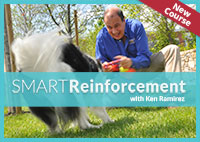

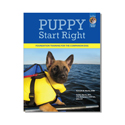
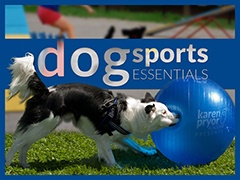
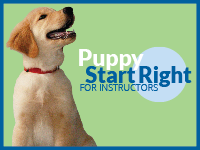

Post new comment